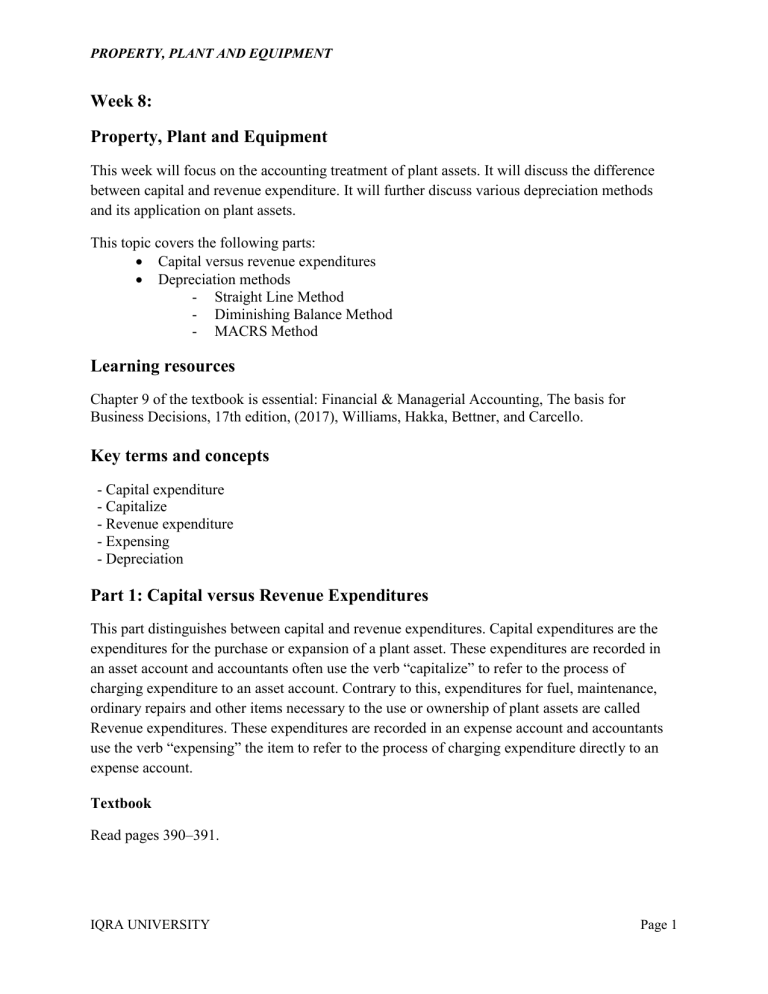
PROPERTY, PLANT AND EQUIPMENT Week 8: Property, Plant and Equipment This week will focus on the accounting treatment of plant assets. It will discuss the difference between capital and revenue expenditure. It will further discuss various depreciation methods and its application on plant assets. This topic covers the following parts: Capital versus revenue expenditures Depreciation methods - Straight Line Method - Diminishing Balance Method - MACRS Method Learning resources Chapter 9 of the textbook is essential: Financial & Managerial Accounting, The basis for Business Decisions, 17th edition, (2017), Williams, Hakka, Bettner, and Carcello. Key terms and concepts - Capital expenditure - Capitalize - Revenue expenditure - Expensing - Depreciation Part 1: Capital versus Revenue Expenditures This part distinguishes between capital and revenue expenditures. Capital expenditures are the expenditures for the purchase or expansion of a plant asset. These expenditures are recorded in an asset account and accountants often use the verb “capitalize” to refer to the process of charging expenditure to an asset account. Contrary to this, expenditures for fuel, maintenance, ordinary repairs and other items necessary to the use or ownership of plant assets are called Revenue expenditures. These expenditures are recorded in an expense account and accountants use the verb “expensing” the item to refer to the process of charging expenditure directly to an expense account. Textbook Read pages 390–391. IQRA UNIVERSITY Page 1 PROPERTY, PLANT AND EQUIPMENT Activity Brief Exercise 9.1 on page 415. Part 2: Depreciation Methods This part discussed the concept of depreciation which is a process of allocating the cost of an asset to expense over the asset’s useful life. The first method is Straight Line Method in which equal portion of the cost of an asset is recognized as a depreciation expense in each period of the useful life on the asset. The graph below shows that depreciation expense under this method remains constant over the useful life of an asset; Annual Depreciaion Expense 12 000 7 000 2 000 1 2 3 4 5 Years The second method is Declining Balance Method in which an accelerated depreciation rate is computed and is applied to the opening book value. The graph below shows that depreciation expense under this method would be high in early years and smaller in the later years of the asset’s useful life; Annual Depreciaion Expense 9 000 6 000 3 000 1 2 3 4 5 Years The last method is MACRS which stands for Modified Accelerated Cost Recovery System. Companies may use straight line method but most prefer this method because of its favorable tax consequences. IQRA UNIVERSITY Page 2 PROPERTY, PLANT AND EQUIPMENT Textbook Read pages 391-397.. Activity Solve the following exercises; Brief Exercise 9.3 on page 415. Brief Exercise 9.6 on page 415. Exercise 9.2 on page 417. Exercise 9.3 on page 417. Exercise 9.7 on page 417. Conclusion This lecture covered two major objectives: Understanding the difference between capital and revenue expenditures. Learning the depreciation methods. References Financial & Managerial Accounting, The basis for Business Decisions, 17th edition, (2017), Williams, Hakka, Bettner, and Carcello. IQRA UNIVERSITY Page 3





